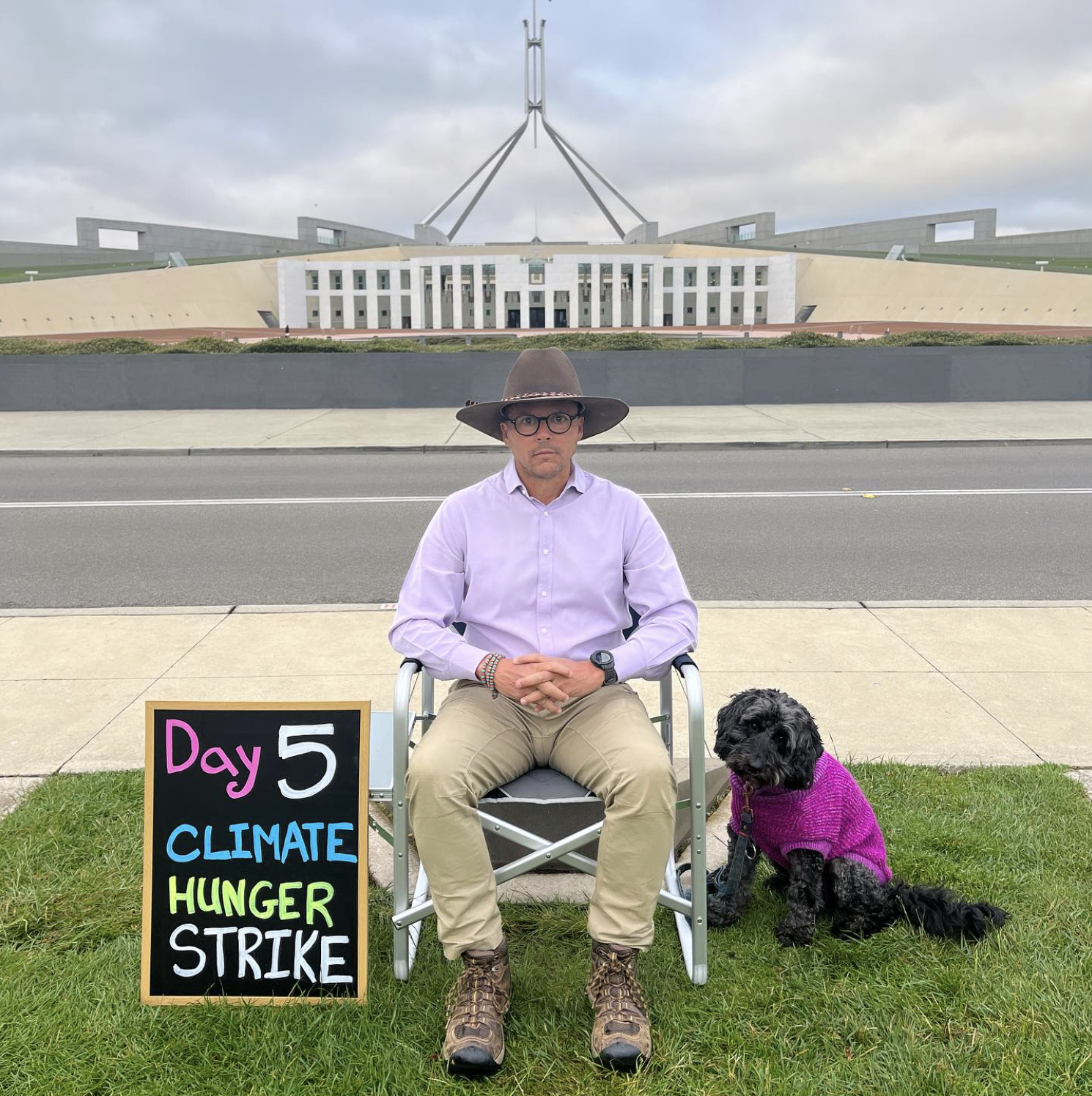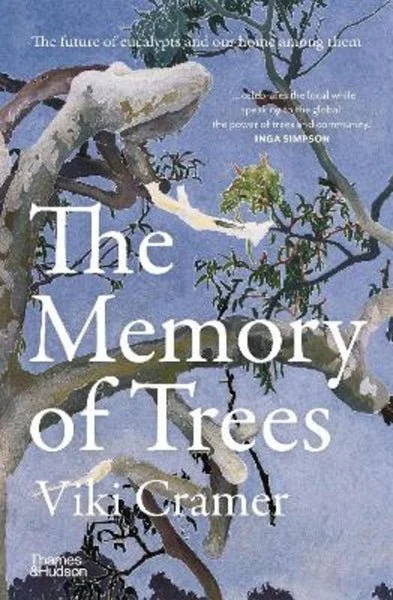CONTENT WARNING. A note from Clare: "While in this Episode, we talk about creativity and hope, baking and Strictly Ballroom, and address a wide range of things from the politics of climate action to biodiversity, we also discuss the details of going on a hunger strike. Personally, I would say that bit is not suitable for children, although I suspect Gregory would disagree. I'd also like to let you know there's mention of eating disorders in this interview. It's a compelling listen - there's much to think about and learn from here, and I admire Gregory's stand and his ethics. But do exercise your own judgement with little or vulnerable/ anxious ears around.
Thank you,
Clare xxx"
How far would you go for climate action? Changing your lifestyle? Sounds doable (to an extent!). Divesting from businesses that support the fossil fuel industry, perhaps? Would you consider getting into politics? Or more controversial actions, like risking arrest at a banned street protest, or harbour blockade, for example? Our guest this week embarked on a much more unusual - and indeed dangerous - strategy to spur the government into stronger action on climate issues.
Gregory Andrews is a former diplomat, and was Australia’s first ever Threatened Species Commissioner. He worked as a public servant for more than 30 years, including for 15 years in the Departments of Foreign Affairs and Trade, Environment, Climate Change, and Indigenous Affairs. Today he's an adjunct Associate Professor at the University of Canberra's Institute for Applied Ecology.
In November 2023, in the run up to COP28, he stationed himself outside Australia's federal parliament, and staged a hunger strike for climate action. His demands included that the government stop permitting the logging of native forests, and end subsidies to fossil fuels companies. He lasted 16 days before ending up in hospital. This is his story.
NOTES
A SWAG is compact sleeping space designed to protect you from the elements when you're camping. Like a sleeping bag with a built-in mattress, that rolls up. Gregory didn’t sleep at Parliament House though - that’s not allowed. He sat there from dawn to dusk, with his folding chair, and later his swag when his body got weaker, then went home to bed every night. No dinner though…
PROTEST OUTFITS Dressing the part can help, depending what you’re trying to say. Business attire to show you mean business? Why not? Bob Brown mentions on Episode 185 that he wore a suit and tie to lead protests against the damming of the Franklin River. Listen here.
ALBANESE GOVERNMENT Australia’s current Labor PM, Anthony Albanese, is fond of the slogan “a better future”. While he’s surely better than the last one - the one who brought a lump of coal into parliament - Gregory says Labor’s climate action has been disappointing. In Auguat 2022, the Albanese government introduced a Climate Change Bill enshrining into law an emissions reduction target of 43 % from 2005 levels by 2030 and net zero emissions by 2050. But the following May, they approved their first new coal mine, making world news headlines - wasn’t this a guy who’d promised to take climate action seriously? More here.
FOSSIL FUEL SUBSIDIES In 2022–23, Australian Federal and state governments provided a total of $11.1 billion worth of spending and tax breaks to assist fossil fuel industries. This year's figure represents a 5% decline on last year's, but subsidies in the forward estimates have increased from $55.3 billion to a record $57.1 billion. Via the Australia Institute.
HUNGER STRIKES have been used by political prisoners, activists and refugees over the decades, sometimes with terrible consequences, including death.
In Russia, for example, in 2019, opposition activist, Lyubov Sobol, went on a hunger strike for 32 days to protest her exclusion from running in local Moscow elections. Ukrainain filmmaker Oleh Sentsov went on hunger strike when he was a political prisoner of the Kremlin. He did this for 145 days, after moving from a total hunger strike to one that included limited nutritional support, and later glucose drips and small doses of protein shakes. But he got very sick. He said, “Of course, you don’t want to die, and I didn’t. My goal was not to die but to win. It’s like in a battle.”
Bobby Sands’ famously hunger striked in 1981. The IRA commanding officer was elected an MP for Sinn Fein while in prison. He died, after 66 days. More here.
Gregory mentions GANDHI. On September 16, 1932, for example, he started a hunger strike from his cell at Yerovda Jail near Mumbai to protest against the British government's decision to separate India's electoral system by caste. In February 1943, when he was 73 years old, he did it again, with a plan for a 21 day fast.
GREGORY’S STRIKE lasted 16 days, from November 1, 2023. When he called it quits, after taking advice from his wife and the parliament house nurse, others came to take over for 24-hour-stints at a time. “Yesterday I had to listen to my body when it started to give out,” he began in a blog post written from hospital . He titled it: “My Body Gave Up But My Determination Hasn’t.” Read it here.
His action came with the below DEMANDS and an associated petition, which at the time of writing has been signed by =.
Stop subsidising fossil fuels and redirect these resources to climate action and adaptation,
Commit to an urgent phase out of Australia's massive coal and gas exports,
End native forests logging,
Update Australia's key environment protection law, the EPBC Act, to includes climate impacts, and
Immediately release key details of the Climate Risk Assessment which outlines the national security risks we face.
The Australia-based Danish climate journalist Mik Aidt, wrote in a piece for the Centre for Climate Safety: “By putting his own health on the line, Gregory Andrews is making a radical and an ethical statement. He tries to catch our attention not by disturbing anyone, or by destroying anything, but by quietly appealing to the conscience of society.” Read the rest here.
DOCTORS CARE ABOUT CLIMATE TOO Doctors for the Environment Australia (DEA) is an organisation of medical professionals that protect human health through care of the environment.
NEWCASTLE PORT PROTESTS & ARRESTS “More than 100 people were charged after a climate change protest at the Port of Newcastle in November. The activists, including a 97-year-old grandfather and a coal miner, had permission for a 30-hour protest at the world's largest coal port but when they refused to leave at 4pm on Sunday, police moved in. Subsequently, 109 people – including 49 males, 60 females, five of which were under 18 – were arrested.” Via 9 News.
LYREBIRD DREAMING is the name of Gregory’s website
Lyrebirds are great mimics, capable of imitating almost any sound. The lyrebird’s syrinx or voice box is the most complex and sophisticated of any song bird. It has three instead of the usual four voice box muscles which gives flexibility. The birds are shy in nature. They are an ancient bird, with the earliest fossil records from about 15 million years ago.
Read about their significance in Aboriginal storytelling and culture here.
GONDWANA “was an ancient supercontinent that broke up about 180 million years ago. The continent eventually split into landmasses we recognize today: Africa, South America, Australia, Antarctica, the Indian subcontinent and the Arabian Peninsula. The familiar continents of today are really only a temporary arrangement in a long history of continental movement.” Via Live Science.
AUSTRALIA has, as Gregory says, “this clean green image. We name our sports teams the WALLABIES and SOCCEROOS and put a kangaroo on the tail of QANTAS. But we have the highest rate of mammal extinction in the world.” Read more here.
BIOABUNDANCE is a quantity that describes the number of individuals of a species in an area of interest, either directly or through other measurements such as biomass or percentage of cover. It is the underlying quantity of interest in a number of ecological investigations, such as monitoring population sizes and studying the spatial or space–time pattern of a single plant or animal species in a region or plot. It is also the key ingredient for analyzing biodiversity, the relative abundance of several or all species in an ecological community.
Says Gregory: “[Australia] is just chockablock with extraordinary animals and plants… there are more eucalyptus species just in NSW than there are tree species in the whole of the UK.”
MORE TREES PLEASE? Listen back to Episode 165 with another Greg, “plant mechanic” Greg Moore. Also, Clare’s just read Vikki Cramer’s fascinating book about Western Australia’s eucalyptus forests, The Memory of Trees. Recommended!
The THREATENED SPECIES BAKE-OFF , say government organisers, “is an invitation to Australians to bake a dessert in the shape of a threatened species. The Bake Off aims to build awareness in the community about Australia’s remarkable and unique threatened wildlife.” More here.
Overall winner of the 2018 competition, a Growling Grass Frog (Litoria raniformis) by EnviroDNA @enviro_DNA. @enviro_DNA, CC BY-NC
Echidna cake. Photo credit @terrainecology, via Australian Geographic
Bandicoot cake! You’re welcome! Thank you for existing @WestBec
Here’s the PIANIST playing as the icecaps melt was Ludovico Einaudi, in this incredibly moving film by Greenpeace…
Thanks for dropping by the podcast recording, Fred.











